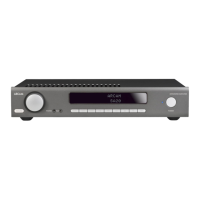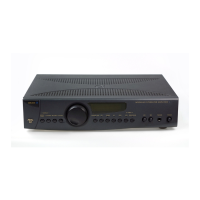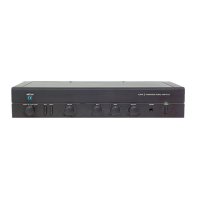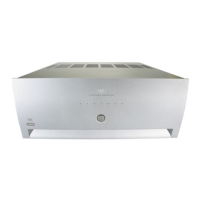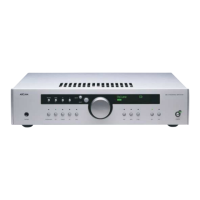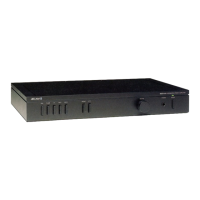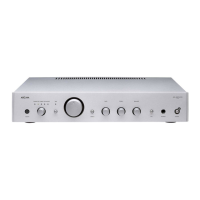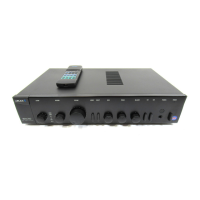1716
DAVE amplifier - Setting up
Continued
There are two different types of video signals. Some equipment is
manufactured to one type, some to the other. One is called either
'S Video' or SVHS (which usually has a higher quality picture), the
other is 'Composite video'.
The DAVE does not convert one to the other.You can connect
equipment sending both types of signal to your DAVE at the same
time. However, you shouldn't connect two similar pieces of
equipment (e.g. an 'S Video' Laser disc and a 'Composite video'
Laser disc at the same time).
If you are connecting some 'S Video', and some 'Composite video'
equipment you must connect your TV (monitor) to both the
'SVHS' and the 'COMPOSITE VIDEO' MON OUT (monitor out)
sockets.
For optimum video performance always use 75 ohm cables
designed for video use.
When watching a videotape that has a copy prohibit signal, eg
Macrovision™, the On Screen Display (OSD) may sometimes
wobble or move slightly.This is normal and does not indicate a
problem with the unit.
COMPOSITE VIDEO CONNECTIONS
See the diagrams below and opposite.
el
VCR OUT
Connect this output socket to the video
input socket of your video recorder.
em
VCR IN
Connect this input socket to the
composite video output socket of
your video recorder.
en
AUX IN
Connect this input socket to the
composite video output socket
of your source.
fm
AV IN
Connect this input socket to the composite video output
socket of your source.
fn
DVD IN
Connect this input socket to the composite video output
socket of your DVD player.
fo
MON OUT (MONITOR OUT)
Connect this output socket to the composite video input of
your TV or monitor.You will probably need a RCA phono to
phono (or phono to SCART in Europe) video cable to do this.
COMPONENT VIDEO CONNECTIONS
Note: these sockets are not normally found on European
equipment.
ek
COMPONENT VIDEO IN
Connect these input sockets to the component video out
put sockets of your DVD player.
fp
COMPONENT VIDEO OUT
Connect these output sockets to the component video
input sockets of your TV or monitor.
CONNECTING TO OTHER EQUIPMENT
S VIDEO CONNECTIONS
See the diagrams above and opposite.
dr
VCR OUT
Connect this output socket to the video input socket of
your video recorder if your VCR is an S Video model.
ds
VCR IN
Connect this input socket to the S Video output socket of
your video recorder if your VCR is an S Video model.
dt
AUX IN
Connect this input socket to the S Video output socket of
your source.
fq
AV IN
Connect this input to the S Video output socket of your
source.
fr
DVD IN
Connect this input socket to the S Video output socket of
your DVD player.
fs
MON OUT (MONITOR OUT)
Connect this output socket to the S Video input of your TV
or monitor.
DIGITAL INPUTS
eo
,
ep
OPTICAL 1, OPTICAL 2
Connect these input sockets to the optical digital output
sockets of your DVD player, CD player, etc.
fl
,
fk
COAX 1, COAX 2
Connect these input sockets to the coaxial digital output
sockets of your DVD player, CD player, etc.
Each of these 4 digital inputs can be individually allocated to
one of these inputs: DVD, AV, AUX, CD,TUNER or VCR.
This is done in the digital input setup page in the setup menu.
eq
SUB (SUBWOOFER PRE-AMP OUT)
Connect this output socket to the input socket of your
active subwoofer, if you have one.
er
SURR. R (SURROUND RIGHT PRE-AMP
OUT)
Connect this output socket to the right hand 'power amp in'
socket of the amplifier connected to your surround (rear)
speakers.
es
SURR. L (SURROUND LEFT PRE-AMP OUT)
Connect this output socket to the left hand 'power amp in'
socket of the amplifier connected to your surround (rear)
speakers.
et
CENTRE (PRE-AMP OUT)
Connect this output socket to the centre 'power amp in'
socket of the amplifier connected to your centre speaker.
DAVE amplifier - Setting Up
Continued
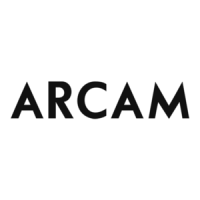
